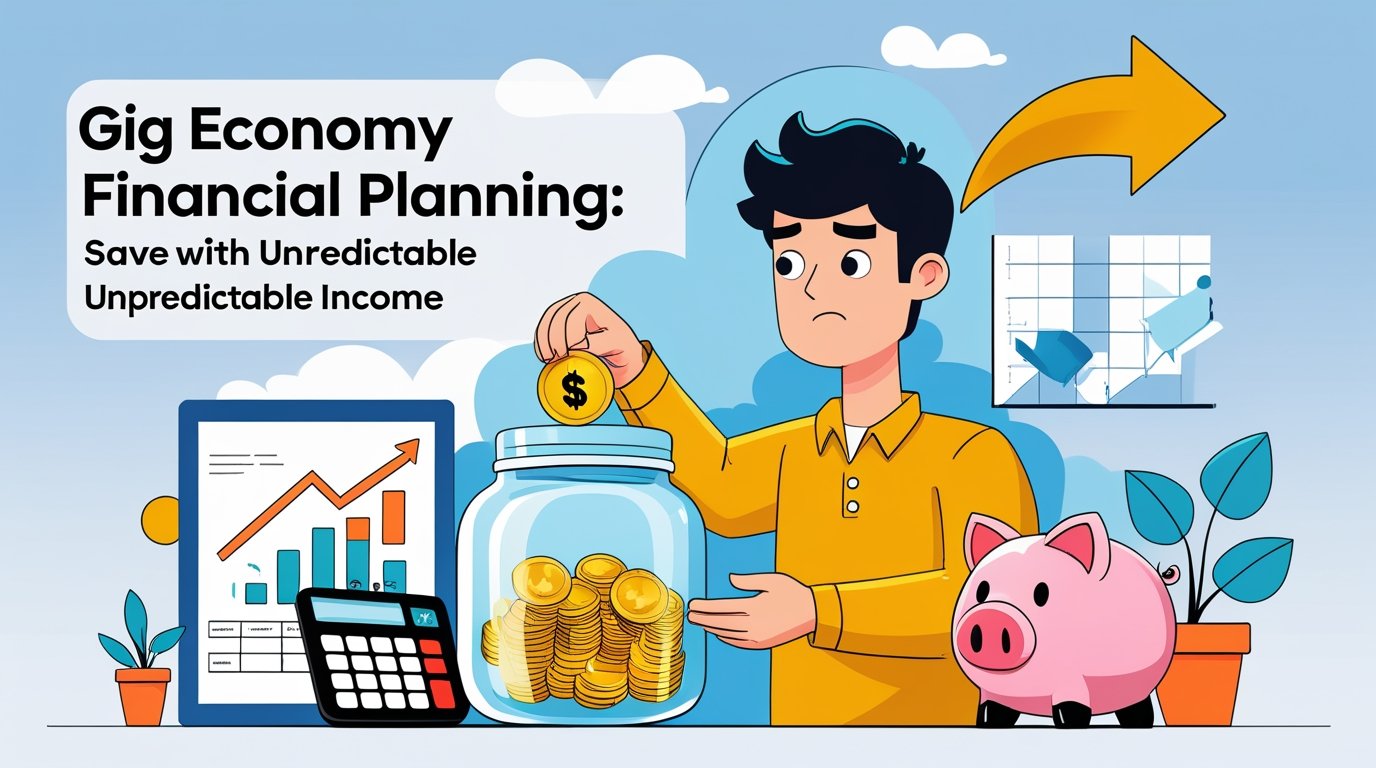The gig economy offers unparalleled flexibility, but it comes with a catch: unpredictable income. Whether you’re a freelance graphic designer, a rideshare driver, or an online content creator, the ebb and flow of gig work can make financial planning feel like navigating a storm without a map. In 2025, with over 40% of U.S. workers participating in the gig economy (source: Statista), mastering saving when income is unpredictable is more critical than ever. This article provides actionable strategies to build a financial safety net, optimize your budget, and achieve long-term stability—without sacrificing the freedom you love. Let’s dive into gig economy financial planning and explore how to thrive in an uncertain income landscape.
Understanding the Gig Economy’s Financial Challenges
The gig economy, characterized by short-term contracts and freelance work, thrives on flexibility but poses unique financial hurdles. Unlike traditional 9-to-5 jobs, gig workers often face:
- Income Volatility: Earnings can fluctuate drastically month-to-month.
- Lack of Benefits: No employer-sponsored retirement plans or health insurance.
- Tax Complications: Self-employment taxes and quarterly filings add complexity.
- Uncertain Workflows: Gigs may dry up unexpectedly, impacting cash flow.
These challenges make financial planning for freelancers essential. Without a steady paycheck, saving requires discipline, foresight, and tailored strategies.
Why Financial Planning Matters for Gig Workers
Financial planning isn’t just about saving for a rainy day—it’s about creating stability in a volatile career. A 2023 survey by Upwork found that 59% of gig workers felt stressed about finances due to income unpredictability. By adopting proactive saving strategies for gig workers, you can reduce stress, prepare for emergencies, and even invest in your future.
Key Strategies for Saving with Unpredictable Income
1. Create a Flexible Budget
A traditional budget assumes a fixed income, which doesn’t work for gig workers. Instead, adopt a flexible budgeting approach:
- Track Your Income: Use apps like QuickBooks Self-Employed or Mint to monitor earnings over 3–6 months and calculate an average monthly income.
- Prioritize Essentials: Allocate funds for rent, utilities, and groceries first. Aim to cover these with your lowest expected income.
- Adjust Discretionary Spending: Scale non-essential expenses (e.g., dining out) based on high- or low-income months.
Example: Sarah, a freelance writer, earns $2,000–$5,000 monthly. She budgets $1,500 for essentials, saves 20% of any surplus, and adjusts discretionary spending based on her income.
2. Build an Emergency Fund
An emergency fund is a gig worker’s lifeline. Aim for 3–6 months of living expenses, but start small if needed:
- Set Micro-Goals: Save $500, then $1,000, and build from there.
- Automate Savings: Transfer a percentage (e.g., 10%) of each gig payment to a high-yield savings account.
- Use Separate Accounts: Keep your emergency fund in a dedicated account to avoid dipping into it.
Tip: Online banks like Ally or Marcus by Goldman Sachs offer high-yield savings accounts with APYs around 4% in 2025, ideal for growing your emergency fund.
3. Plan for Taxes
Gig workers are responsible for self-employment taxes (15.3% in the U.S.) and quarterly estimated tax payments. To avoid surprises:
- Set Aside Tax Money: Save 25–30% of each payment in a separate account.
- Track Deductions: Log business expenses (e.g., home office, equipment) to reduce taxable income.
- Consult a Professional: A tax advisor can help optimize deductions and ensure compliance.
Resource: Check the IRS Self-Employment Tax Guide for detailed requirements.
4. Diversify Income Streams
Relying on a single gig platform is risky. Diversifying income sources can stabilize cash flow:
- Explore Multiple Platforms: Combine work from Upwork, Fiverr, and TaskRabbit.
- Develop Passive Income: Create digital products (e.g., eBooks, courses) or invest in dividend-paying stocks.
- Upskill: Learn high-demand skills like AI prompt engineering or digital marketing to access better-paying gigs.
Case Study: John, a rideshare driver, added freelance video editing and sold stock footage online, increasing his monthly income by 30% and reducing reliance on one platform.
5. Invest for the Future
Saving isn’t just about emergencies—long-term financial planning ensures you’re prepared for retirement or big purchases:
- Open a Solo 401(k) or SEP IRA: These retirement plans are designed for self-employed individuals and offer tax advantages.
- Start Small: Contribute even $50/month to a low-cost index fund via platforms like Vanguard or Fidelity.
- Compound Interest: A $100 monthly investment at a 7% annual return could grow to over $80,000 in 30 years.
Internal Link: Learn more about retirement planning for freelancers.
6. Leverage Financial Tools and Apps
Technology can simplify gig economy financial planning. Here are top tools for 2025:
| Tool | Purpose | Cost |
|---|---|---|
| QuickBooks Self-Employed | Track income, expenses, and taxes | $15–$30/month |
| YNAB (You Need a Budget) | Flexible budgeting for irregular income | $14.99/month or $99/year |
| Acorns | Micro-investing for beginners | $3–$5/month |
Visual Suggestion: Include a screenshot of YNAB’s budgeting interface to show how it categorizes irregular income.
What’s New in 2025 for Gig Economy Financial Planning
The gig economy continues to evolve, and 2025 brings fresh opportunities and challenges:
- AI-Powered Gig Platforms: New platforms like AI-driven task marketplaces are emerging, offering higher-paying gigs but requiring specialized skills.
- Tax Law Updates: Proposed U.S. tax reforms may increase deductions for gig workers. Stay updated via TurboTax’s Gig Economy Hub.
- Crypto Payments: Some platforms now offer cryptocurrency payments, adding complexity to income tracking but opening new investment avenues.
Tip: Use crypto tax software like CoinTracker to manage digital currency earnings.
Pros and Cons of Gig Economy Financial Planning
| Pros | Cons |
|---|---|
| Flexibility to adjust savings based on income | Requires discipline to save consistently |
| Opportunity to diversify income streams | No employer-sponsored benefits |
| Access to modern financial tools | Complex tax obligations |
FAQ Section: Actionable Answers for Gig Workers
How can I save money when my income fluctuates monthly?
To save with unpredictable income, prioritize a flexible budget and automate savings. Calculate your average monthly income over 6 months and allocate 10–20% of each payment to a high-yield savings account. Use apps like YNAB to adjust spending based on income highs and lows. For example, if you earn $3,000 one month and $1,500 the next, always cover essentials first and save a portion of the surplus during high-income months.
What’s the best emergency fund size for gig workers?
Aim for 3–6 months of living expenses, but start with $1,000. Gig workers face higher income volatility, so a larger emergency fund (6 months) is ideal. Save in a high-yield account (e.g., Ally Bank) to earn interest. For instance, saving $200/month at 4% APY could build a $6,000 fund in 2.5 years.
How do I handle taxes as a gig worker?
Set aside 25–30% of each payment for taxes in a separate account. Track deductible expenses like internet costs or equipment using QuickBooks. File quarterly estimated taxes to avoid penalties. Consult a tax professional or use IRS resources for guidance.
Can I invest as a gig worker with irregular income?
Yes, start with micro-investing apps like Acorns or low-cost index funds via Vanguard. Contribute small amounts ($50–$100/month) to a Solo 401(k) or SEP IRA. Over time, even modest investments grow through compound interest. For example, $50/month at 7% return could grow to $20,000 in 20 years.
What tools help with gig economy budgeting?
Top tools include QuickBooks Self-Employed for tax tracking, YNAB for flexible budgeting, and Mint for expense monitoring. These apps sync with bank accounts, categorize income, and provide insights to optimize savings. Most offer free trials, so test them to find the best fit.
How do I diversify my gig income in 2025?
Explore multiple platforms (e.g., Upwork, Fiverr), develop passive income (e.g., eBooks, affiliate marketing), and upskill in high-demand areas like AI or digital marketing. For example, a graphic designer could offer logo creation on Fiverr and sell templates on Etsy.
Conclusion: Take Control of Your Gig Economy Finances
The gig economy offers freedom, but financial planning for freelancers is non-negotiable for long-term success. By creating a flexible budget, building an emergency fund, planning for taxes, diversifying income, and leveraging financial tools, you can save effectively despite unpredictable income. Start small, stay consistent, and use 2025’s new tools and opportunities to secure your financial future. Share your top saving tips in the comments or sign up for our newsletter for more gig economy financial planning strategies!

